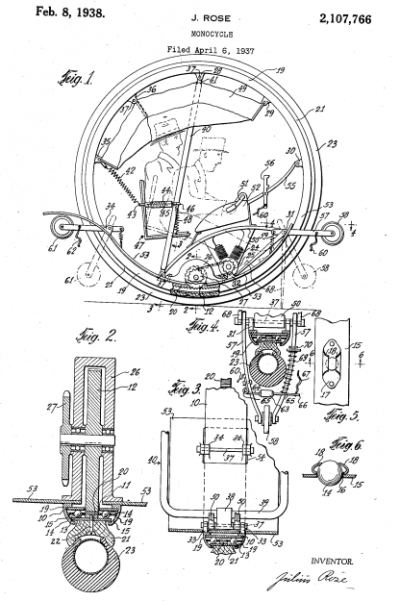Here it is. (by Chase Holfelder)
Previously: Here Is The Soulful Acoustic Smash Mouth Cover You Didn’t Know You Wanted
The bicycle is one of the most common inventions in the world. Some of us see hundreds of them every day! Others of us stare constantly at one specific bicycle, lonely in the corner of our living room, silently judging us as we get into our car each morning.
And yet, most of the bikes we see day-to-day are very similar. Bicycle design has seemed to reach a general consensus culture-wide. But the bicycle we consider typical today was once known as the “safety bicycle”, presented as an alternative to the much more perilous penny-farthing:
…that class of bicycles or velocipedes called safety, in which the wheels are nearly or quite of equal size, the object being to facilitate easy steering and at the same time to prevent the front wheel from swerving from side to side as power is applied to the pedals, this fault being common to machines of this class. — Gearbox patent application, 1888
Of course, there do remain variations in the bikes of today — there are recumbent bikes, and tall bikes, and little clown bikes. Smart people have figured out how to make collapsible bikes, or bikes grown out of bamboo. Individual components of the bike have been iterated upon and improved over time.
But what radical improvements in whole-bike design have yet to catch hold with the world at large? Having had great success with my prior research into improved forks, I decided to put random cycling-related words into Google’s patent search database until I could answer this question.
Here are the results.
IMPROVED BICYCLE 1.
Lean velocipede, U.S. Pat. No. 3,860,264 (1975)

CLASSIFICATION:
• Tricycles
This is a design patented by Mattel in the seventies. Here’s their pitch:
DESCRIPTION OF THE PRIOR ART
Numerous types of three-wheeled toy velocipedes are well known. For the most part, such velocipedes, or tricycles, are propelled by means of a pair of pedals mounted on the front wheel and are steered by means of handlebars which control the front wheel.
While small children quickly master the operation of such standard tricycles, they experience great difficulty in attempting to operate a unicycle.
Thus, the majority of small children are limited to riding tricycles, yet remain fascinated by a unicycle because it may be propelled and steered without the use of one’s hands.
This is a tricycle that works like a unicycle with training wheels. (Which, by the way, also exist, in many different forms.) It solves the pressing problem of…children not knowing how to ride unicycles, I guess?
You can buy this exact Mattel invention, right now, for seventy bucks plus shipping (or, I guess one of you can, and the rest of you will have to weep over the lost opportunity):
GRADE: C+. Half unicycle/half tricycle just averages back out to a bike.
IMPROVED BICYCLE 2.
Systems and methods for combination scooter and pogo stick, U.S. Pat. No. 8,226,094 (2012)

CLASSIFICATION:
• Bicycles without a seat, i.e. the rider operating the vehicle in a standing position, e.g. non-motorized scooters; non-motorized scooters with skis or runners
This, my good friends, is a combination scooter and pogo stick.
DETAILED DESCRIPTION
…The present disclosure combines the functionality of both pogo sticks and scooters into one single device. […]
When the user wishes to use the combination scooter and pogo stick as a scooter in “scooter mode” to horizontally or laterally traverse flat or inclined surfaces, the user simply arranges the scooter board portion horizontally and has the stubbed bottom portion stick out horizontally and not contact the ground… The user may also hold on to the handlebars to facilitate horizontal or lateral movement once moving with the combination scooter and pogo stick in “scooter mode”.
When the user wishes to use the combination scooter and pogo stick as a pogo stick in “pogo stick mode” to traverse vertical obstacles, move vertically, or to jump up and down in a vertical motion, the user arranges the scooter board portion vertically, latches the scooter board in securely with a holding member, and holds onto the handlebars and uses a spring as well as the stubbed bottom portion to jump up and down in a vertical motion.
The inventor has also provided the following handy flow chart, for all your many pogo scooting needs. It may come in handy when using the pogo scooter to “traverse vertical obstacles” as the inventor intended.

I put up that exact flow-chart on my basement wall using index cards and yarn, just to confuse people in case I ever become a serial killer.
GRADE: C-. Really missing the background information that explains how existing inventions cannot adequately answer the needs of the modern pogo-scooter enthusiast. I mean, it’s obvious to me and to everyone reading, but it needs to be in the record.
IMPROVED BICYCLE 3.
Self-propelled unicycle engagable with vehicle, U.S. Pat. No. 9,211,932 (2015)

CLASSIFICATION:
• Cycles not otherwise provided for
(This is a U.S. patent, but I had to look up the images in the parallel Chinese patent application.)
This does not actually look like a bicycle in the traditional sense. But that’s okay! We’re examining IMPROVED bicycles, and what could possibly be more of an improvement to the lowly bicycle than this, which I believe is something out of Akira?
But this rad-looking device isn’t here in the patent application all by itself. What’s being patented is a unicycle “engagable with vehicle.”
What could that mean? Let’s consult the patent document:
BACKGROUND
…Packaging bicycles in or on a vehicle during transportation creates difficulties, especially with relatively small vehicles. An interior of a vehicle may be reconfigurable, e.g., seats may be folded, to accommodate a bicycle in the interior of the vehicle.
However, the bicycle disadvantageously consumes valuable interior space of the vehicle and can disadvantageously move within the vehicle during unexpected acceleration or deceleration.
Bicycles can alternatively be stored on an exterior of a vehicle during transportation. For example, after-market racks are available for mounting to vehicles and supporting one or more bicycles.
However, these after-market racks are expensive to purchase. Assembly of the after-market rack to the vehicle and assembly of the bicycle onto the rack is also disadvantageously time consuming. The rack and the bicycle also disrupts airflow around the vehicle during travel, thereby disadvantageously decreasing fuel economy of the vehicle.
Accordingly, there remains an opportunity to design a device for multi-modal transportation that is easily and compactly integrated with the vehicle. (Emphasis added)
To summarize: It’s good to have both a big vehicle (car) and a small vehicle (bike), but what if there were a better way to transport the two things together? That is, rather than having to shove a bike into or on top of the car, or (they don’t mention this option specifically) towing the car around with your bike?
HERE…
IS THEIR ANSWER

What is claimed is: a self-propelled unicycle for selectively engaging the suspension system for use with the vehicle and selectively disengaging the suspension system for independent use…
Let me reiterate that: This anime-style scooter IS ALSO A WHEEL OF YOUR CAR. It’s easy to transport because you can’t drive off without it.
I look forward to the day when disengaging a wheel from your car is preferable technology to a car-mounted bike rack.
Who’s behind this particular innovation? Who was the patent granted to?
Why, it’s FORD GLOBAL TECHNOLOGIES LLC.
Just you wait. This is going to be an available feature on the 2028 Focus.
So, do they expect that you’ll park your car, unhook this weird unicycle machine and zip off, leaving your car sitting there looking like the Google parking lot is suddenly a really bad neighborhood?
For the answer, let’s look at the document’s caption to the image above that shows the car:
FIG. 1 is a perspective view of a vehicle with four self-propelled unicycles engaged with a suspension system of the vehicle.
Easy as pie.
It’s not a unicycle hooked up to a car. It’s a car riding on four unicycles.
GRADE: B-. This is absolutely an improvement on the humble bicycle. Unfortunately, it’s being developed by Ford, so we know they’re gonna screw it up.
IMPROVED BICYCLE 4.
Monocycle, U.S. Pat. No. 2,107,766 (1938)

CLASSIFICATION:
• Unicycles
This totally looks like something that would have been invented in 1938. The image is a bit of a mess, so let’s see what clarity we can gain from the description:

It goes on like this for a few pages. Until, the handy summation:
![]()
Ah. Of course.
GRADE: D+. A little too similar to that one South Park episode for comfort.
IMPROVED BICYCLE 5.
Simple Bike, U.S. Pat No. 4,653,767 (1987)

CLASSIFICATION:
• Cycles convertible to, or transformable into, other type of cycle or land vehicle
Finally: what is this little tiny thing? Is it supposed to be a compact, collapsible bike? Is it a collapsible little tiny circus bike? A collapsible little tiny circus bike that a clown would ride around?
Let’s review the patent:
SUMMARY OF THE INVENTION
A principal object of the present invention is to provide a two-wheeled bicycle that can be easily disassembled so as to form a standard, one-wheeled paddle bike and the other a separate unicycle.
Another object is to provide a simple bike which, when fully assembled, serves as a bicycle for an individual, but when disassembled, provides a separate vehicle for each of two friends to use at the same time.
WAIT
WHAT
when disassembled, provides a separate vehicle for each of two friends to use at the same time.
LOOK AT THAT THING. Go back, scroll up and look at that picture again.
Picture hanging out at the quad with your friend.
Picture unfolding your Simple Bike.
“I guess I’ll just walk to class,” says your friend, glum.
“Wait,” you say, and you unlock the Simple Bike’s two independent components.
Your friend smiles the biggest smile you’ve ever seen.
“Do you want the standard, one-wheeled paddle bike,” you say with a grin, “or would you prefer the separate unicycle?”
“You choose,” says your friend, and the two of you ride off to class together.
squeeka squeeka squeeka squeeka squeeka squeeka squeeka squeeka
GRADE: A+. Rush this into production immediately.
Previously: Improving the Fork
I really enjoyed this short film, The Reinvention of Normal, about the artist Dominic Wilcox.
Wilcox makes strange objects, such as a soccer ball that you can put fruit inside so it becomes a smoothie as you kick it around.
He makes a lot of things like that, and he describes in the film how making a lot of things quickly has helped him tap into his creative instincts in a clarifying way.
As a person who derives an immense amount of joy from puttering around in my own workshop, making a lot of stupid things that occasionally end up not always being stupid, I am quite drawn to this line of thinking.
“I enjoy the playfulness,” he says, over footage of a car he designed covered completely in stained glass. “and just doing things — even though they’re completely ridiculous sometimes. So what? Let’s do the ridiculous. And by doing the ridiculous, something else might come of it!”
Here’s another video, as well, of him giving a talk at a conference… The first seven minutes are the same video above, and then there’s another bit with him explaining and demonstrating some of the strangers things he’s made, like the stained-glass car, or a set of GPS-enabled bespoke-leather shoes.
“It’s always difficult to describe what I am,” he says in the talk. “I work between art, design, invention, technology, craft… Really, I’m just a person who’s trying to be as creative as I possibly can be.”
Here are a few of the many Roll-a-Sketch drawings I did at Maker Faire this year!
Thank you to everyone who came by and said hello; I saw a lot of returning faces. Maker Faire is a super fun environment to be immersed in for a few days — you’re surrounded by robots, and art cars, and 3D printers, and drones, and everyone’s just interesting. I had many lovely and surprising conversations with creative folks.
I have never been to any of the other, subsidiary Maker Faires — only the flagship show in San Mateo, which has a wholly enclosed, Vatican-City-style craft fair section that is technically what I am there as part of. But in the coming year I hope to make fewer papergoods and more tangible “weird things” so who knows, there may be room for me at another city’s Maker Faire yet.
FLAMINGO + TELEPHONE:
BLENDER + ROLLER DERBY:
SNOWMAN + BUG:
PUNISHER + 8-BALL:
VEGETABLE + VIKING + BATMAN + CINDER BLOCK:
BLENDER + COP + BUTLER + BEAR:
WALRUS + HELICOPTER + DOLPHIN + 8-BALL:
ALSO: We’re getting close to the end of May, which means it’s time to reveal the Wondermark Cast Card that’ll be going out to Patreon subscribers!
This month’s card features Boutrous, the camel from the classic Wondermark #558, “In which a Camel is merely ordinary”.
(This particular comic was also narrated in audio form by voice actor SungWon Cho, here. It’s…super good.)
The monthly Patreon Cast Card subscription, so far, has been going out to a HIGHLY EXCLUSIVE GROUP. Later in the year, there will be another new “achievement” Cast Card that you’ll be able to get in a different way… And of course, the Roll-a-Sketch “Patron of the Arts” card is available at all my convention appearances this year.
Thank you very much to all you Patreonauts, at any level! We’re very close to a $500 goal that will prompt the start of a monthly annotation series, in which I go back through the archives and puzzle out just what I was thinking for comics deep in the archive.
Last month we crossed the THIRTEEN YEAR MARK with Wondermark. A decade ago, I was a very different person, in a very different place in my life. I don’t write comics the same way now as I did then, mostly for the better (I hope), but who knows. I think it’ll be interesting to go back and interrogate my younger self. That’ll become a monthly thing once we crest $500 on Patreon.
I am very grateful for your support via any method: Patreon, the store, saying hello at a show, or just a word to a friend. I’m thankful for every kindness — it’s always been, and continues to be, a privilege to do this for you, and by reading this you are by definition a Cool Person with Good Taste.
NICE
WORK
I’m at Maker Faire this weekend in San Mateo! I’ll be in the “San Francisco Bazaar” tent, near the flame-belching Wurlitzer.
I’ve been making some new things in the ol’ workshop: laser-engraved magnets!
I’ll have these at the show this weekend, and other shows throughout the year. (They’ll probably go online too, eventually.)
WE HOLD THESE TRUTHS TO BE SELF-EVIDENT: